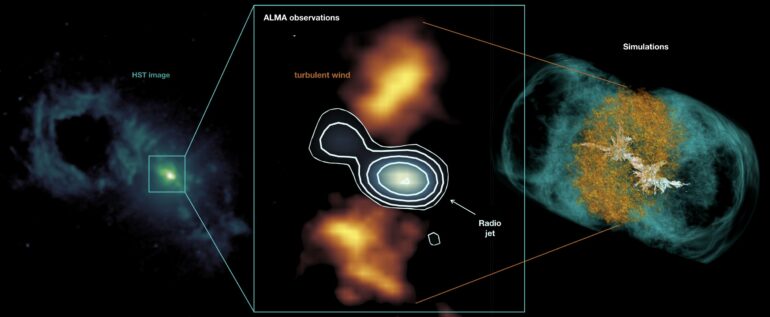When matter falls into supermassive black holes in the centers of galaxies, it unleashes enormous amounts of energy and is called an active galactic nuclei (or AGN). A fraction of AGN release part of this energy as jets that are detectable in radio wavelengths that travel at velocities close to light speed. While the jet travels across the galaxy, it collides with the clouds and gas around it and in some cases may push this material away in the form of winds. However, which conditions preferentially trigger these winds to blow out the gas from galaxies are still poorly understood.
The effect of jets impacting the content of the galaxies, like the stars, dust, and gas, plays an important role in how galaxies evolve in the universe. The most powerful radio jets, hosted in “radio-loud” galaxies, are responsible for drastically changing the fate of galaxies because they heat the gas, preventing new star formation and galaxy growth. Computer simulations of relativistic jets piercing into disky galaxies predict that jets alter the shape of the surrounding gas by blowing bubbles as they penetrate further into the galaxy. One of the key elements in the simulations that make the jets efficient in driving winds is the angle between the gaseous disk and the jet’s direction of propagation. Surprisingly, less powerful jets, like the ones in “radio-quiet” galaxies, are able to inflict more damage on the surrounding medium than the very powerful ones.
An international scientific team, led by the IAC researcher Anelise Audibert, discovered an ideal case in which to study the interaction of the radio jet with the cold gas around a massive quasar: the Teacup galaxy. The Teacup is a radio-quiet quasar located 1.3 billion light years from us and its nickname comes from the expanding bubbles seen in the optical and radio images, one of which is shaped like the handle of a teacup. In addition, the central region (about 3,300 light-years in size) harbors a compact and young radio jet that has a small inclination relative to the galaxy disk.
Effects on star formation
Using observations performed in the Chilean desert with the Atacama Large Millimeter/submillimeter Array (ALMA), the team was able to characterize with an unprecedented level of detail the cold, dense gas in the central part of the Teacup. In particular, they detected the emission of carbon monoxide molecules that can only exist under certain conditions of density and temperature. Based on these observations, the team found that the compact jet, despite its low power, is not only clearly disrupting the distribution of the gas and heating it, but also accelerating it in an unusual way.
The team expected to detect extreme conditions in the impacted regions along the jet, but when they analyzed the observations, they found that the cold gas is more turbulent and warmer in the directions perpendicular to the jet propagation. “This is caused by the shocks induced by the jet-driven bubble, which heats up and blows the gas in its lateral expansion,” explains A. Audibert. “Supported by the comparison with computer simulations, we believe that the orientation between the cold gas disk and the jet is a crucial factor in efficiently driving these lateral winds,” she adds.
“It was previously believed that low-power jets had a negligible impact on the galaxy, but works like ours show that, even in the case of radio-quiet galaxies, jets can redistribute and disrupt the surrounding gas, and this will have an impact on the galaxy’s ability to form new stars,” says Cristina Ramos Almeida, an IAC researcher and co-author of the study.
The next step is to observe a larger sample of radio-quiet quasars with MEGARA, an instrument installed on the Gran Telescopio CANARIAS (GTC or Grantecan). The observations will help us to understand the impact of the jets on the more tenuous and hot gas, and to measure changes in star formation caused by winds. This is one of the goals of the QSOFEED project, developed by an international team led by C. Ramos Almeida at the IAC, whose aim is to discover how winds from supermassive black holes affect the galaxies that host them.
More information:
A. Audibert et al, Jet-induced molecular gas excitation and turbulence in the Teacup, Astronomy & Astrophysics (2023). DOI: 10.1051/0004-6361/202345964
Provided by
Instituto de Astrofísica de Canarias
Citation:
Discovery of relativistic jets blowing bubbles in the central region of the Teacup galaxy (2023, March 21)



